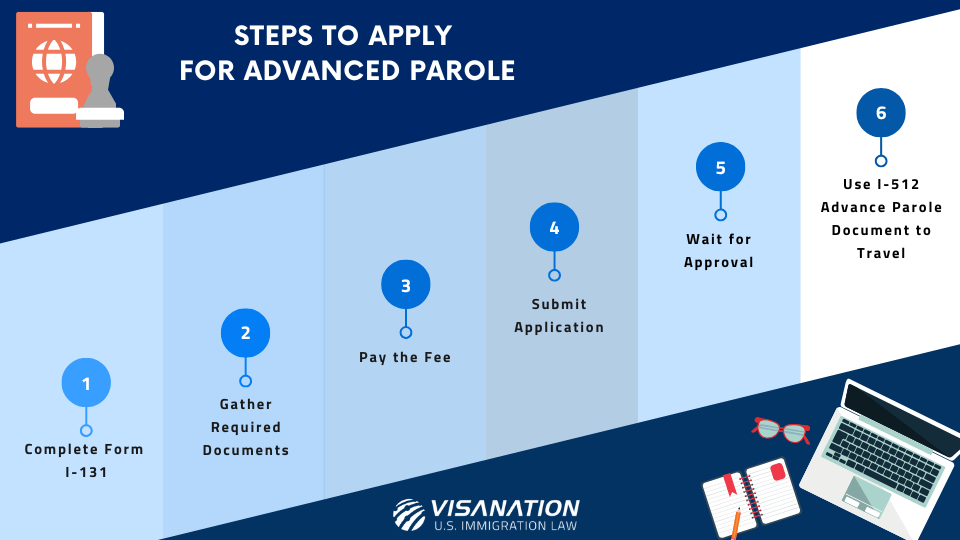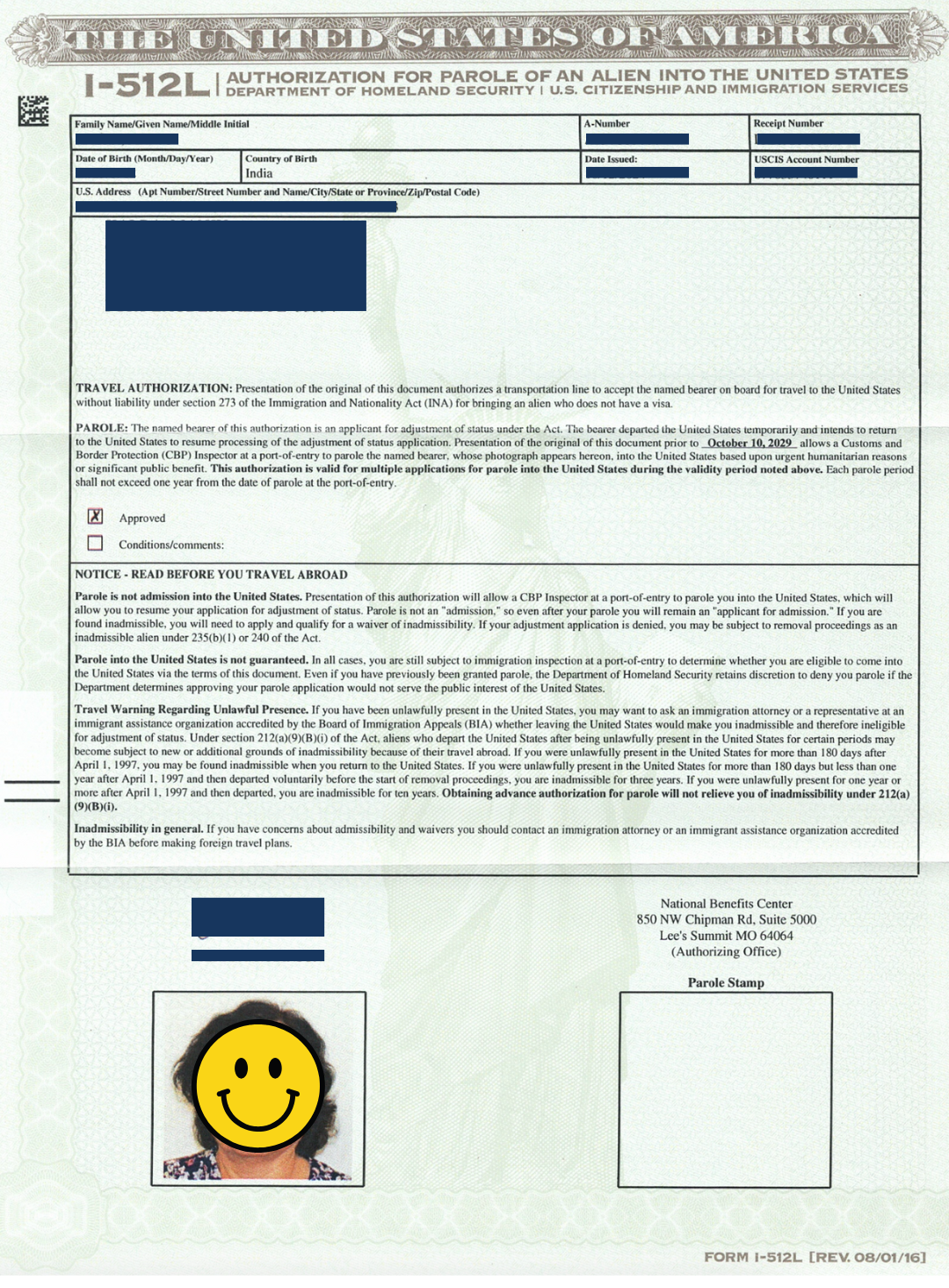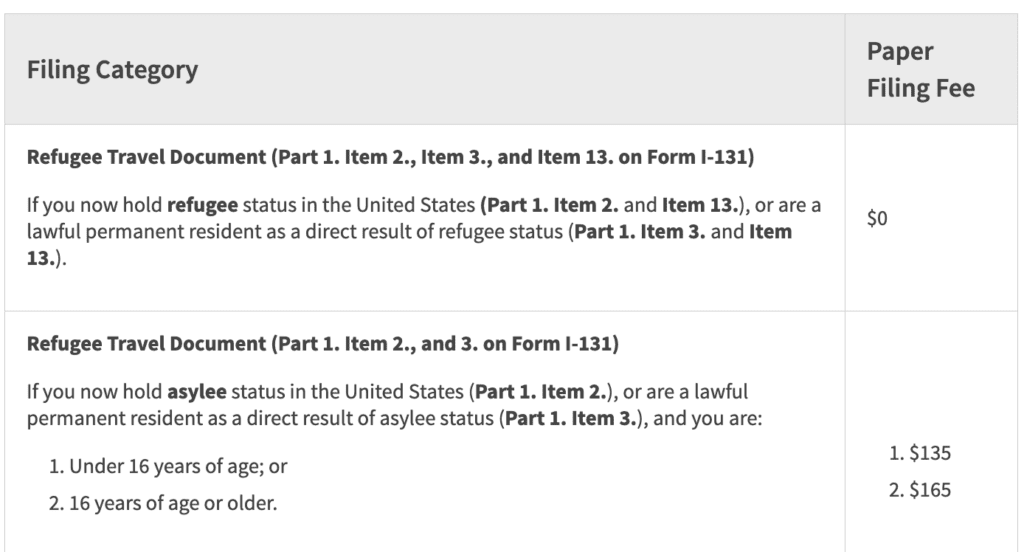Advance parole (I-512) is a special permission granted by USCIS in the form of a travel document. It allows you to temporarily travel overseas while living in the United States and awaiting your green card or maintaining another noncitizen immigration status. If you travel outside of the United States while your green card application is pending without a valid I-512 advance parole document, your application can be considered abandoned, leading to its termination.
In this guide, we’ll explore how to apply for advance parole, the consequences for not obtaining it, who is eligible to apply, and more!
In our latest video, VisaNation Attorney Shilpa Malik provides insights into everything you need to know about traveling outside the U.S. via an I-512 advance parole document.
Who is Eligible For An Advance Parole Document (I-512)?
You may be eligible to apply for an I-512 Advance Parole Document if you meet one of the following criteria:
- Have a pending adjustment of the status application (I-485)
- Were admitted into the United States as a refugee
- Have a pending asylum case
- Are a beneficiary of the Family Unity Program, which provides immigration relief to family members of certain lawful temporary residents,
- Are a Temporary Protected Status (TPS) Recipient
Below is a comprehensive description of who else might need to apply for I-512 advance parole depending on your immigration journey.
- Adjustment of Status Applicants: Any applicant for an adjustment of status who still has a pending case needs to obtain advance parole before leaving the U.S. to prevent USCIS from considering their case abandoned. You do not need to specify the reason for your travel when applying for I-512 advance parole and requests are generally accepted for whichever type of adjustment of status application you have pending (employment, family, asylum, refugee, etc.)
- Learn about H-1B Travel While I-485 is Pending.
- Asylum Applicants: If you are an asylum applicant you will need to get advance parole before departing the country for temporary travel in order to avoid USCIS from considering your pending I-589 abandoned. In these cases, if the travel is not absolutely necessary, it is often recommended to not depart the U.S. while your application is pending because if you return to the country you are claiming to escape persecution from, it can hinder the basis of your claim.
- Temporary Protected Status Recipients: Those who have received TPS need to have advance parole before departing the United States to avoid violating the continuous physical presence requirement for upholding temporary protected status.
- Other Non-Citizens: Individuals with another form of non-citizen status like recipients of humanitarian parole under section INA 212(d)(5) can receive advance parole if they can prove that their travel is from an emergency humanitarian reason or benefits the public good.
“Any person who is not a U.S. citizen or noncitizen U.S. national is subject to immigration review each time the person seeks admission to the United States from any place outside the United States. Even if you have already been admitted as a permanent resident (you have a Green Card) you are subject to review by an immigration official. If, during such review, you are determined to be inadmissible (even though you may have been admissible previously), you may be denied admission.”
To apply, you will use form I-131. The next section outlines the steps to take to get travel authorization.
Steps to Apply for Advance Parole Document (I-512)
Below are the steps most people will use to obtain advance parole.
Step 1: After determining eligibility, file Form I-131. Under “reason for travel” and “travel dates” on the form, be specific about your intentions.
Step 2: Gather the necessary documents necessary to prove your eligibility.
Step 3: Submit an application and pay filing fees (for a check, money order, or credit card payment use Form G-1450)
Step 4: After submitting your application you will receive a receipt notice (Form I-797) and you may also be scheduled for a biometrics appointment to submit fingerprints, a photo, etc.
Step 5: Await your approval

Once you receive the approval you will be able to use the I-512 Advance Parole Document to travel!
Airlines accept the I-512 advance parole travel document (the same way they would a visa) as proof from the government that you can reenter the country.
Note that this does not replace your passport so still travel with that as well. Also, be aware that U.S. Customs and Border Protection has the right to deny you entry at an airport or border crossing even if you have advance parole, based on their determination.
Most commonly, individuals who have a pending Form I-485, Application to Register Permanent Residence or to Adjust Status or a pending Form I-589, Application for Asylum and for Withholding of Removal apply for advance parole.
Should you fail to obtain advance parole and leave the U.S. while Form I-485 is still pending then USCIS will reject your case, with the exception if you meet certain criteria for individuals with nonimmigrant statuses. The same goes if you leave while your asylum case is pending without receiving advance parole then USCIS will assume that you have abandoned your case.
It’s always best to consult an immigration attorney to evaluate the proper procedure for your case. Get started with VisaNation
Form I-131, Application for Travel Document
Form I-131 is the application used to request various types of travel documents, including Advance Parole. However, it is distinct from the I-512 Advance Parole Document, which is the actual authorization received after your I-131 application is approved.
Form I-131 can be used to apply for:
- Re-entry permits (for permanent residents),
- Refugee travel documents (for refugees and asylees),
- Advance parole (for individuals with pending immigration cases, including humanitarian parole),
- Advance permission to travel for CNMI long-term residents.
See the latest version of Form I-131 here.
The 01/20/2025 edition of Form I-131 replaces previous editions of Form I-131 (Application for Travel Document). Starting 4/4/2025 USCIS will only accept the 01/20/2025 edition. Until that date, you can also use the prior edition(s).
How to Submit Form I-131 for Advance Parole with Your Green Card Application
Once you apply for I-512 advance parole using Form I-131, you will receive Form I-512L, Authorization for Parole of an Alien into the United States. The most efficient way to apply for advance parole is to submit Form I-131 alongside your green card application (Form I-485). The advantage is that there is no additional fee for advance parole if you submit both forms together. Be sure to include a copy of your photo I.D. (like the photo page of your passport) and two passport-sized photos.
If you’ve already submitted your green card application and need a travel document, you can still submit Form I-131 separately. In this case, include a copy of your photo I.D., two passport-sized photos, and the receipt notice for your green card application showing that you paid the application fee.
If you’re applying for a reentry permit using Form I-131, you can leave the U.S. after attending your biometrics appointment and pick up your travel documents at a U.S. consulate or embassy overseas (if this option was requested when submitting your application).
What Does the I-512L Look Like?
The I-512L is an advance parole document issued to those in the process of adjusting their status (those with a pending Form I-485)

Form I-131, Application for Travel Document
While Form I-131 is also an application for a travel document, it is different than the I-512 Advance Parole Travel Document. Form I-131 is used to apply for re-entry permits, refugee travel documents, advance parole travel documents (including parole into the U.S. for humanitarian reasons), or advance permission to travel for CNMI long-term residents. See the latest version of Form I-131 here.
The 01/20/2025 edition of Form I-131 replaces previous editions of Form I-131 (Application for Travel Document). Starting 4/4/2025 USCIS will only accept the 01/20/2025 edition. Until then, you can also use the prior edition(s).
I-131 Filing Fee
The base I-131 paper filing fee is $630 but can vary depending on your situation. See the below chart with relevant fees based on the type of travel document you are seeking.


If you are a TPS beneficiary in the U.S. and are applying for a Travel Authorization Document, the paper filing fee is $630.
Advance Parole vs Reentry Permit
The main difference is that a reentry permit is issued to permanent U.S. residents while advance parole is granted to foreign nationals who don’t have permanent resident status.
They are very distinguishable in their appearance because a reentry permit resembles a passport whereas an advance parole approval is a single piece of paper with the individual’s photo.
If you are using an advance parole document to reenter the country be sure to still carry your passport with you. To get a reentry permit, you would need to file Form I-131.
Travel Authorization/Advance Parole for DACA Recipients
Alert: Important Update on DACA: On Jan. 17, 2025, the U.S. Court of Appeals for the Fifth Circuit issued a decision regarding the DACA Final Rule. Pursuant to the court’s order, USCIS will continue to accept and process DACA renewal requests and accompanying applications for employment authorization under the DACA regulations at 8 CFR 236.22 and 236.23. USCIS will continue to accept initial requests but will not process initial DACA requests at this time. Current grants of DACA and related Employment Authorization Documents remain valid until they expire unless individually terminated.
I-512 Advance Parole for Education, Study Abroad, Academic Research
If you are a DACA recipient, you should apply for Advance parole using Form I-131. DACA recipients can get advance parole if travel is necessary for employment (training, conferences, meeting clients, etc.), educational (study abroad programs or academic research), or humanitarian reasons.
DACA Advance Parole Humanitarian Reasons
- Medical treatment -Evidence such as a letter from a physician or medical facility detailing the diagnosis and care required.
- Services for a deceased relative – Evidence that a member of the family has passed and you need to attend a funeral
- Visiting a sick relative – Medical documentation confirming the relative’s condition and a statement explaining why your presence is essential.
After you’ve applied for it then you will receive Form I-512L, Authorization for Parole of an Alien into the United States. The most efficient way to submit the I-131 in tandem with your green card application (Form I-485). The benefit is there is no extra fee if you submit them at the same time. Include a copy of your photo I.D. like the photo page in your passport in addition to two passport-sized photos.
If you have already submitted your green card application and need a travel document you can still do so separately. When submitting Form I-131, include a copy of your photo identification, the two passport-sized photos, and a copy of your receipt notice from your green card application that shows you paid the application fee.
I-131 applicants for reentry permits can leave the U.S. after attending their biometrics appointment and pick up their travel documents at the U.S. consulate or embassy overseas (should be requested on the I-131 application).
Advance Parole Frequently Asked Questions
Below you will find answers to the most commonly asked questions about this topic:
Why do I need a travel document?
Green cards can often take months to years to process and in that time people typically need to travel for business, to visit family and a number of other reasons. You need to get advance parole while your green card is pending to avoid having it considered abandoned and then denied as a result. If this happens you would have to go through the paperwork process all over again and pay the fees again. In many cases, it’s advantageous to apply for advance parole at the same time as you submit your green application. The travel document card will be valid for one year after being issued.
What does it mean if my online I-94 shows my class of admission as “DA”?
This typically means you have been admitted to advance parole as that is the class of admission assigned to those who have.
Can I leave the U.S. before I receive my travel document?
No, do not leave the country until you have it in hand to avoid consequences.
How can I check the advance parole processing time for my travel document?
USCIS updates processing times once a month.
Who is not eligible for advance parole?
You cannot be eligible for advance parole if you are currently under removal proceedings, currently living in the U.S. without a valid immigration status after entering illegally, currently have a valid previously issued reentry permit or travel document (unless it was lost or returned to USCIS), or are the beneficiary of a private bill.
How long does it take to get advance parole?
As of March 2025, the processing times range from 8-22 months depending on the service center adjudicating your application. If you require emergency advance parole it’s best to request it with Form I-131, Application for Travel Document, alongside your immigration attorney’s advice regarding supporting evidence.
How many times can I travel with advance parole?
You can travel multiple times with advance parole, as long as the document is valid. Each reentry is allowed during the validity period of the advance parole, as long as it remains unexpired.
What if I file Form I-131 to request advance permission to travel for CNMI long-term residents document but don’t receive it and travel?
If you leave the U.S. without the advance permission travel document then your status will be automatically terminated.
Is advance parole with Form I-131 eligible for a fee waiver?
At this time it is not eligible. If, however, you have a pending adjustment of status application filed with Form I-485 (on or after July 30, 2007) and you paid that fee, then you can receive advance parole without needing to pay the additional I-131 fee.
What information do I need to detail on the advance parole request?
You need to provide all the standard biographic information as well as the reason for your travel, which country/countries you will visit and the reason for the advance parole request.
Am I guaranteed reentry into the U.S. after getting advance parole?
No, you are not guaranteed entry because Customs and Border Protection still needs to inspect everyone who enters the country and if they find you inadmissible under section INA 212(a) then they can deny your entry even with advance parole.
How can I expedite advance parole?
In some situations, you may be able to get expedited processing for your advance parole application. Situations include emergency humanitarian reasons, urgent financial hardship for an individual or company, etc. Consult your lawyer if you require expedited processing.
If I don’t have current lawful status in the U.S. can I get advance parole?
No, you need to have lawful U.S. status in order to be eligible for the advance parole permission to reenter the U.S. upon departing.
Are advance parole and a re-entry permit the same?
No, they are different. Advance parole is only for non-residence and comes as a document card which is valid for one or two years. Reentry permits are granted to U.S. residents (typically for two years) and look like a passport book.
If I have H-1B status and come back into the United States with Parole can I extend my H-1B status?
You are permitted to apply for an extension to your H-1B status if you resume working with your H-1B employer after reentering the county and do not work according to an Employment Work Document or with another employer.
How long can I stay out of the U.S. with my advance parole?
You can stay outside the U.S. for no longer than the duration of your advance parole card and these are typically valid for 1-2 years. Check your specific card for details. However, you must attend fingerprinting and green card interviews, so long absences may interfere with your green card application process.
If I have over a year of unlawful presence, should I still get advance parole?
Yes, you should still apply for an advance parole document. If you travel outside of the United States with advance parole and in your past accumulated over a year or 180 days+ of unlawful presence you will still not trigger the three or ten-year bar of inadmissibility because it won’t count as a “departure” due to the AP.
Is it safe to travel with I-512 advance parole?
Yes, it is safe to use but if your green card is still pending, it is typically advised to avoid traveling unless it is an emergency or absolutely necessary.
Does my advance parole document replace my passport or does advance parole count as legal entry?
No, it does not replace your passport but it does act in lieu of a visa so while it permits re-entry after overseas travel, the final decision ultimately remains in the consideration of Customs and Border Protection.
Who is eligible for advance parole?
Foreign nationals who have a pending adjustment of status application are eligible, as well as those under the Family Unity Program, foreign nationals who applied for asylum as well as Temporary Protected Status.
How long does it take to get approval and can advance parole be denied?
Yes, it can be denied and it can take 2-3 months or more to have your application processed due to COVID-related backlogs and delays.
How long is advance parole valid?
It is typically valid for one year and it can be used to enter the country multiple times. When it is presented upon entering the United States, it will be stamped.
What are the benefits of Advance Parole?
One of the benefits is that it allows you to reenter the U.S. after traveling overseas without needing to go through the entire process of obtaining a visa. The second really important benefit is that it maintains your pending application with USCIS whether it is an adjustment of status application or other pending application.









